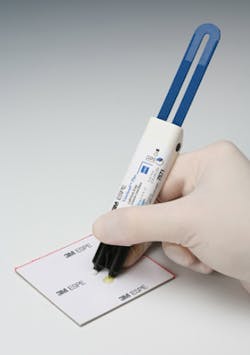When and why you should use a liner/base
Editor's Note: Please contact your state dental board or visit DANB's state-specific information page to verify allowable dental assisting functions and requirements in your state.
By Krissy Dail, DA
In our practice, we have traditionally used resin modified glass ionomer (RMGI) liner/bases for deep cavities and composite procedures. By their nature, RMGI liners are typically fluid materials that can adapt more readily to the internal aspects of a cavity preparation. In the past three years, our practice has become accustomed to using RMGI liner/base products with almost every procedure. As a dental assistant, it’s crucial to know when and why RMGI liner/base products should be used as well as what your role is in placing the product.
Our practice uses a RMGI liner/base on practically every procedure because of the added benefits for patients. In addition to providing a foundation for the restoration, RMGI liner/bases provide extra protection for your patients by preventing microleakage under the restoration, inhibiting bacterial growth, reducing sensitivity, and releasing fluoride into the tooth. Additionally, they’re very easy to place and offer versatile protection for many types of restorations.
Here is a brief overview of the key benefits of using a liner/base:
• Prevents microleakage — Today’s RMGI liner/base materials offer a stronger bond to the dentin than traditional glass ionomers, resulting in less leakage under the composite. RMGI liner/base products seal the tooth and strongly bond to the restoration to reduce the incidence of microleakage between the tooth and the restoration.
• Inhibits bacterial growth — If you place a composite restoration and there is leakage underneath the restoration, the RMGI liner/base will prevent your tooth from becoming infected by releasing fluoride into the tooth. The uptake of fluoride by the tooth tissue results in a reduction of artificial root surface caries.
• Reduces postoperative sensitivity — RMGI liner/bases offer a strong bond to the tooth, sealing the tooth structure to protect against microleakage. This strong bond to the tooth structure can help reduce postoperative sensitivity. RMGI liner/bases can even be used as a clinically effective way to treat dentin hypersensitivity.
• Releases fluoride in the tooth — While flowable composites do not release fluoride, the RMGI liner/base we use — 3M™ ESPE™ Vitrebond™ Plus Light Cure Glass Ionomer Liner/Base — actually releases fluoride into the tooth for protection long after the restoration is placed. This fluoride has been shown to reduce the incidence of secondary decay.
• Provides quick and easy placement — Liner/base materials are available in different forms and delivery systems. Some manufacturers offer dispensing options that cut down on some of the preparation time. 3M ESPE offers a Clicker Dispenser that makes the liner/base even easier to mix and apply because a consistent mix is dispensed each time. We appreciate the peace of mind knowing that the material is mixed right every time and maintains the same consistency use after use. Because of this consistency and chemical makeup, Vitrebond Plus liner/base allows for a quick technique and excellent handling, making placement a breeze for the doctor.
• Helps reduce the effect of shrinkage — As composite resin material cures, it shrinks. RMGI liner/base materials have shown a greater ability to reduce the effect of polymerization shrinkage than flowable liners.
• Versatile protection for every restoration — RMGI liner/bases can be used under both direct and indirect restorations, and offer excellent performance under composite, amalgam, ceramic, and metal, which is why the material lends itself well to nearly every procedure in our practice. They also deliver excellent adhesion without the use of any dental adhesive system.
As a dental assistant, your responsibility involves prepping the patient’s tooth and getting the material ready for the dentist. It is important to prep the tooth adequately by removing any decay, cleaning the tooth, and generally ensuring that nothing is left on the tooth. This is an integral part of the process, as adequately prepping the tooth ensures that the RMGI liner/base can bond to the dentin without leakage.
The next step is to prep the liner/base material. For the product we use, we mix the formula on the mixing pad with the spatula for about 15 seconds. Then the dentist applies a thin layer (about ½ mm) of the liner/base to the tooth. After the application, he or she cures the liner/base for 20 seconds. If the dentist thinks the restoration needs more liner, he or she will apply additional material.
Understanding the uses for RMGI liner/bases and their benefits will allow you to educate your patients about this important step in the restorative process, and help ensure they don’t experience postoperative sensitivity.
Author bio
Krissy Dail is a dental assistant for Drs. Robert G. Ritter and Christopher D. Ramsey in Jupiter, Fla. She received her diploma in dental assisting from the University of Florida, and has been working in dentistry for more than 14 years. She takes pride in helping patients create beautiful smiles they can be proud of.
